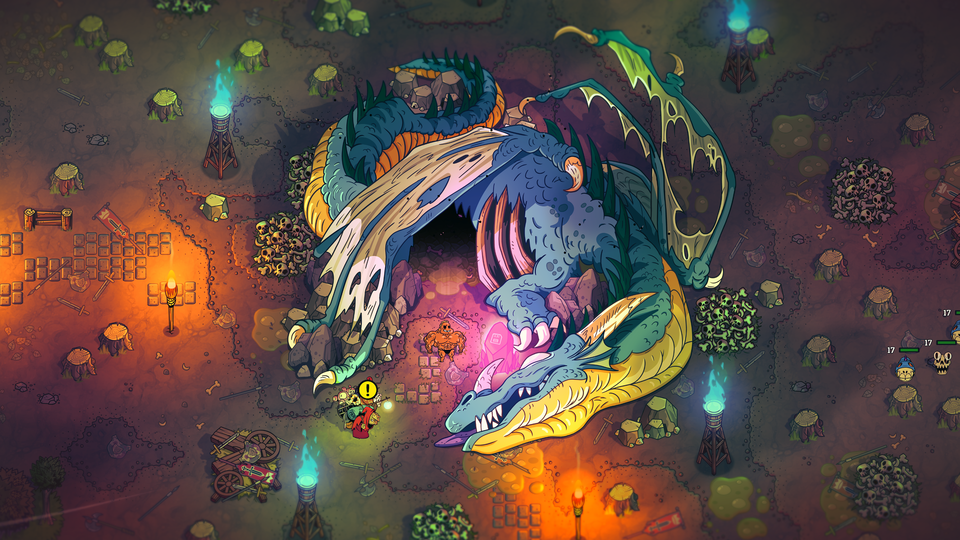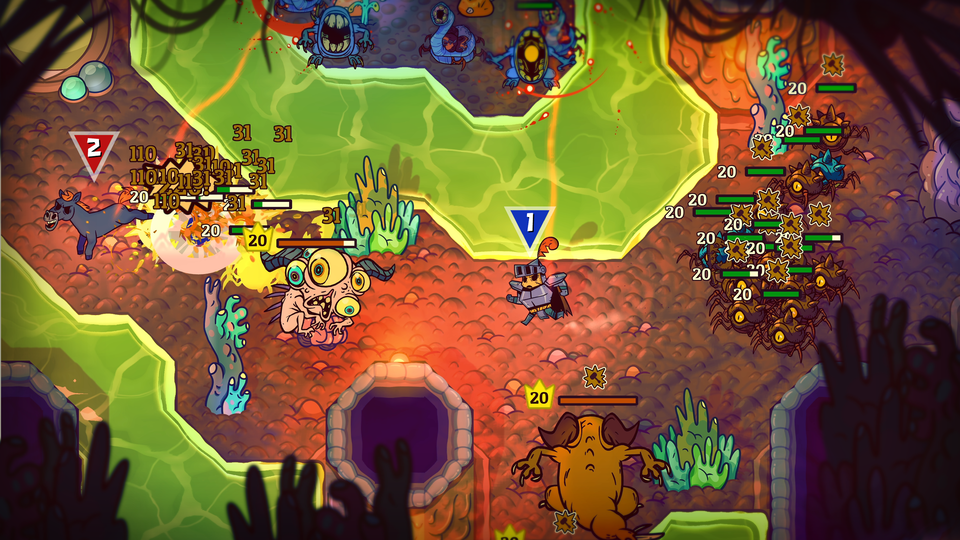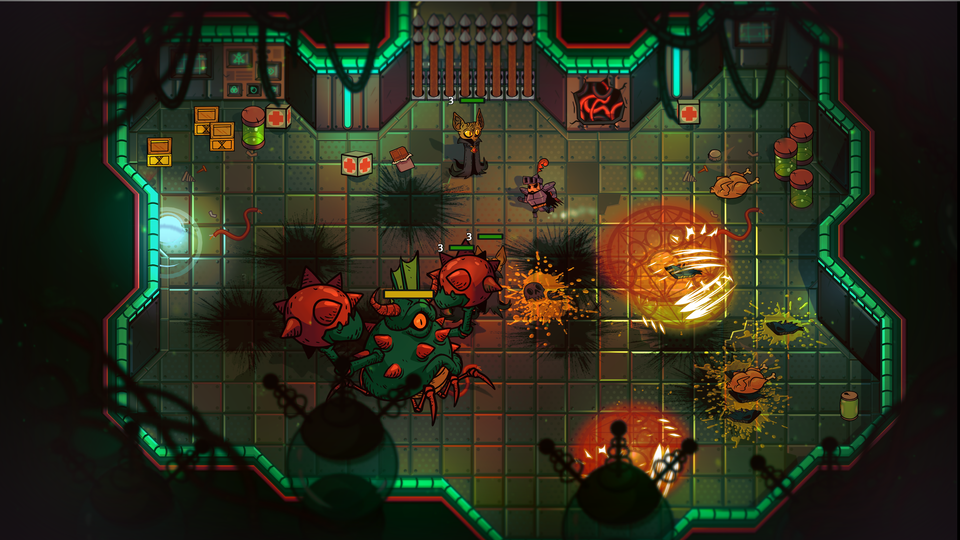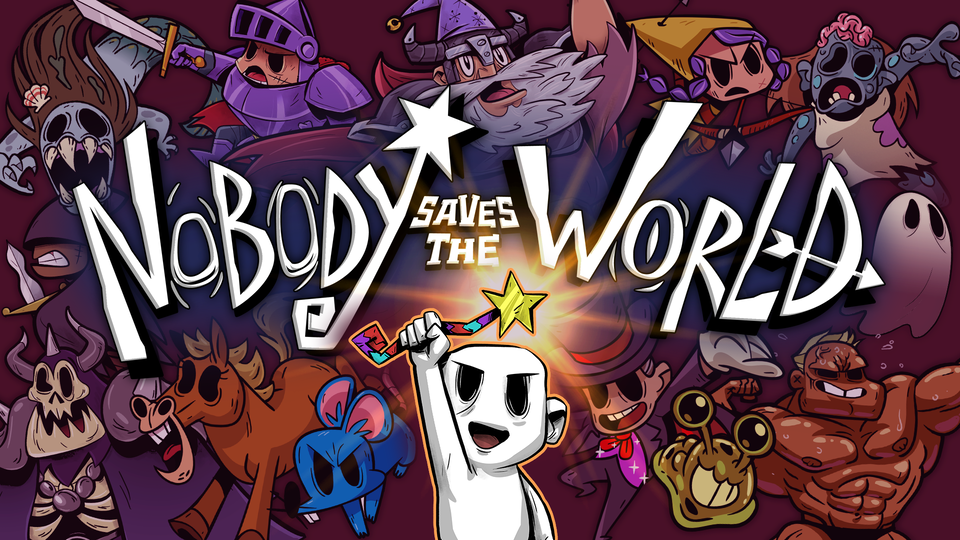
Nobody Saves the World is the latest title from Drinkbox Studios, the indie game developers behind the Guacamelee games. Instead of offering an exotic twist on the Metroidvania, this game plays it safe as a top-down action RPG in the style of early Diablo and Zelda games. That’s not to say it’s basic; the central gimmick of transforming into different creatures adds a surprising level of complexity that encourages multiple playthroughs.
Nobody Saves the World
Developer: Drinkbox Studios
Publisher: Drinkbox Studios
Platform: PC, Xbox Series S|X (Reviewed), Xbox One
Release Date: January 18th, 2022
Players: 1-2
Price: $24.99
I played this game on a Xbox Series X, mostly on the big screen, but for a short time on a smaller screen using remote streaming. Surprisingly, it looks much better when shrunken down.
The setting and visual design for Nobody Saves the World is somewhat disappointing. The smooth animations, thick lines, vivid colors, and goofy character designs are presentable, but it feels amateurish in a way that takes away from the overall experience. Combat animations keep the direction and range of your attacks clear— but it’s at further expense to the visual style. The melee-focused Guard waves his sword around with telekinesis and the rat’s bite is twice the size of his body, but both animations clearly demonstrate where your attack is going to hit.
It feels like Drinkbox Studios attempted a dark fantasy style similar to Klei Entertainment’s Don’t Starve, but it lacks a similarly consistent aesthetic. Jim Guthrie did an admirable job crafting a dynamic soundtrack that changes as you enter different areas of the map, but the lo-fi approach sometimes sounds like hold music. No disrespect to Guthrie, but you won’t miss out on a whole lot if you decided to mute the in-game music and listen to something else.
However, one standout area of this game’s presentation is lighting, which adds depth to the 2D sprites. In a handful of locations, like the shimmering crystals in the Crystal Mines, the green torches lighting The Expanse, or the reflective floors of the Golden Temple, the lighting does a ton of legwork to elevate the experience. Unfortunately, other special effects such as blurring or clouds around the screen’s edges are more trouble than they’re worth— especially when using long-range characters like the Rogue or Ranger.
Nobody Saves The World takes place in an irreverent fantasy setting, with a smattering of post-apocalyptic and Lovecraftian elements. It’s lighthearted with a major focus on humor, both in the design and dialogue.
Some of the jokes are inoffensive, like subtle visual gags and Easter eggs referencing previous titles in Drinkbox’s library. Other references are more blatant, such as a character whose dialogue is based on the infamous Navy Seals copypasta and an item shop achievement titled “Whaddaya Buyin?” There are a few jokes a bit more highbrow, such as a mutant living in a toxic waste dump who eloquently defends nuclear power as a cleaner form of energy than fossil fuels. Unfortunately, none of these jokes are particularly funny.
Aside from that, Nobody Saves The World’s narrative arc is a standard hero’s journey, where the titular Nobody is called to action after acquiring a wand that allows they/them to transform into a variety of creatures. The player is tasked with exploring the world to learn new forms, fight monsters, clear dungeons, and complete hundreds of quests. Bits of lore reveal themselves as the game progresses, but (thankfully) not enough to necessitate a Bioware-style codex.
Keep in mind that this game is much more balanced towards the “Action” part of “Action RPG.” There are no branching paths, and any alternative dialogue options are played for laughs. If you end up spending a lot of time playing this game, it won’t be because of any gripping narrative.
The closest comparison I can make to Nobody Saves The World’s overall design is the remake of Link’s Awakening. You travel across a large flat map populated by towns, dungeons, secret paths, and tons of monsters. The layout for most of the world feels extremely basic— narrow pathing with one main route and several branching paths that offer collectibles of one kind or another. There are some standout locations in the second half of the game, such as The Expanse and The Path of Doom, but for the most part it doesn’t make much of an effort to resemble a natural environment.
The same could be said for the dungeons; many of them are randomly generated, which adds a roguelike element to each encounter. Ultimately, this feels like a lazy attempt at replayability. Randomized dungeons don’t provide the same feel of a handcrafted map, and there’s nothing here that’s as memorable as the dungeons in any Zelda game. That being said, some of the traps and pre-designed modules make for interesting navigation challenges, such as poison fog, shooting daggers, labyrinthine furniture placement, and spinning blades of varying size.
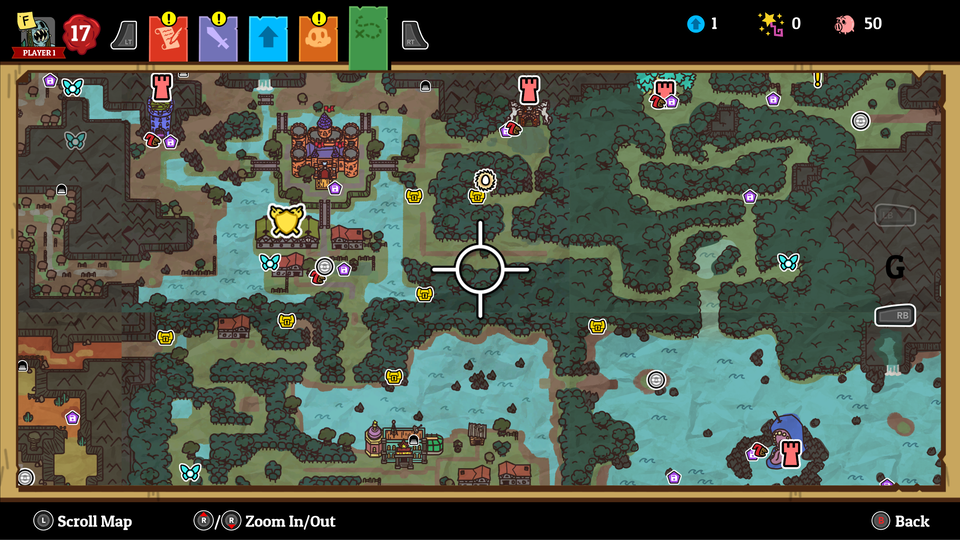
The HUD is clean and unobtrusive, but the pause menu is a bit more complicated. There are several tabs that help you keep track of your quests, roles, and upgrades— but it took me about 12 hours of playing before I realized you could instantly pull up the map by pressing the left trigger. Pressing face buttons will only let you pause to adjust settings or open up the quest page; but considering the rapid pace in which you’ll complete these quests, it makes sense to have this page conveniently accessible.
One aspect of this game’s design leaves a lot to be desired: the radial menu that allows you to quickly swap between forms. There’s no ability to set specific roles to one part of the menu, so you’ll scramble to find the one you want most of the time. This is in real game time too; you don’t get a courtesy slowdown like the modern DOOM games, so your character is vulnerable when quick swapping roles. Improving this aspect of the UI would be a significant improvement, and it diminishes an otherwise fluid playing experience.
Nobody Saves The World provides a steady dopamine drip: XP and stars from completing quests, and money and upgrade tokens from defeating monsters and opening chests. Unlocking new roles and power ups requires you to uniquely implement each move in your arsenal during combat— which is a brilliant way to ensure players get to experience the depth this game has to offer. But after a point, completing these goals loses its charm; it feels like a mobile game at times with all the shiny objects the game throws at you.
Progressing through the story requires you to earn Stars, which are given to you one or two at a time while completing these quests. On several occasions, I found myself grinding past the point where it felt like the game wanted me to. Before I completed the first story dungeon, I had to leave the tutorial area briefly to respawn wandering enemies in order to earn the 15 stars necessary to unlock the castle. Earning 40 stars for the next 3 story dungeons is an even longer grind, but 65 stars for the last two dungeons is torture. This is where the amusing sidequests turn into mandatory tasks, and the entire experience starts to feel like doing homework before you get to reach the next level.
Excessive grinding is a negative, but it actually adds a level of resource management to quests and dungeons. I saved some optional dungeons until I was a higher level so I could steamroll through them in a few minutes while checking off side quests to level up one of my characters. However, the game clearly discourages this practice; most low level enemies will run away from you, and killing them won’t allow you to complete tasks for your role. At one point, I found myself doing suicide runs over and over in the same location to level up some of the last few roles— which feels like bad game design.
By equipping different abilities to your forms, you can complete quests that reward you with Stars and additional abilities. Coming up with specific builds to get through encounters is fun, albeit clunky due to the aforementioned issues with the quick swap menu; but this is almost endearing, since it adds to the difficulty almost like a survival horror game. Some side quests take advantage of these customizations in interesting ways, like the witch race, the bullet hell dungeons, and the turtle mating quest. In this aspect, the combat feels similar to Supergiant Games’ Hades, but with a lot more control over your weapons and boons.
In the early game, I was able to complete several dungeons with two characters. The Ranger’s bow attack offered consistent ranged damage, and I equipped the Guard’s AoE as an effective fallback once the enemies got too close. When that didn’t work, I would switch to the Rat, who could dodge enemies while attacking, stack poison damage, and heal with the Egg’s Incubate ability. But once I unlocked the Necromancer, I was able to constantly refill my health and magic while swarming enemies with my familiars— which allowed me to breeze through the last part of the game.
Not every role is immediately useful; some feel more like HM slaves in Pokemon, where you only level them up to unlock context-specific abilities. The healing effects gained from both the Egg and the Zombie fit this description, as does the Mermaid’s ability to navigate the handful of water levels found in the overworld.
Nobody Saves The World is at it’s best when rapidly switching between roles to work around the enemy’s buffs or recover HP and mana. The best feeling of “flow” comes from successfully navigating a huge wave of enemies or an encounter in a tight space. When I went to bed at the end of each play session, I could still see the game while my eyes were closed— a phenomenon known as the Tetris Effect that indicates a deeply immersive experience.
My first playthrough took about 20 hours; the game crashed only once, and I only lost a few minutes of progress. The rebalancing offered by New Game+ and online co-op make it very tempting for me to start my next playthrough— although the bog-standard setting and milquetoast humor slightly dampen my enthusiasm.
Despite some minor gripes, Nobody Saves the World is an excellent retro action game with razor-sharp mechanics that I highly recommend.
Nobody Saves the World was reviewed on Xbox obtained through Xbox Game Pass. You can find additional information about Niche Gamer’s review/ethics policy here.
